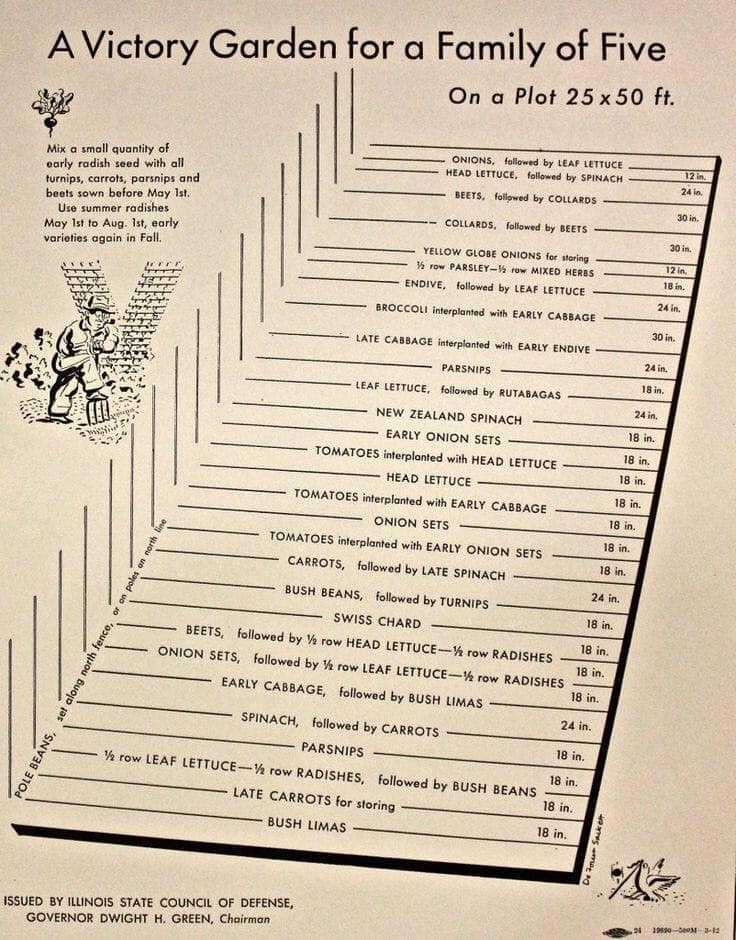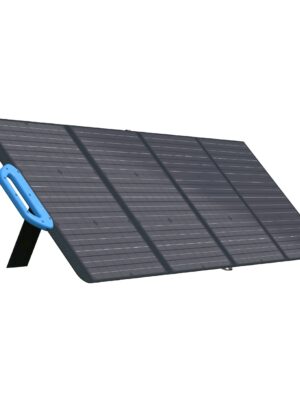Prep School Daily: What’s Your Garden Plan? Leave a comment
The
following image is a garden plan issued by the state of Illinois
sometime during World War II. I shamelessly copied the image which was
posted at Last Stand on Zombie Island
and reposted on a forum I frequent. I’m just going to assume that this
is something that really was promoted by the state of Illinois at the
time.
So what do you think as you review this early infographic? My first thoughts:
- There
aren’t any potatoes. Maybe potatoes were one crop that was plentiful
and still shipping everywhere. Maybe they just didn’t grow well in
Illinois, but that doesn’t seem likely. - I’ve never even eaten parsnips, rutabagas, collards, or turnips.
- I
loathe radishes, but I have seeds for them. Radishes are the earliest
crops to reach maturity, which can be really important in times of
scarcity. - I also don’t like head lettuce. Much prefer leaf lettuce. Of course, there is no way to preserve either of these.
- I’m not very fond of beets, either. Or lima beans.
- Where are the melons, cucumbers, and squash?
- No corn or strawberries?
- No garlic?
Maybe there was a second page, but I doubt it.
Rule
#1: Never rely on the government. Of course, if you’re reading this
blog, you already know that rule. I’m seriously disturbed that
long-keeping sources of vitamins and calories like winter squash and
potatoes are not included in the above garden plan. Using that plan as a
guideline, families would have two dozen different types of vegetable
seeds on their shopping list and think they must have covered all the
bases. But several of those vegetables can only be eaten fresh–not
canned, not frozen, and definitely not stored for the long term. None
are high in calories.
Rule #2: Learn from history. This
plan was written for a time when most domestic production crops and the
resultant canned goods was destined for supporting the troops in the war
efforts overseas. Because gasoline and tires were also rationed, there
just wasn’t the means to transport fresh produce to grocery stores. We
got a taste test of rationing and short supplies last year. What
happens with a much more serious crisis?
Rule #3. Be adaptable.
The above garden plan assumes that families will be canning their
excess produce. However, as we saw last year, canning lids disappeared
from store shelves. They still haven’t returned. Amazon has a lot of
sellers offering canning lids for pretty reasonable prices.
Unfortunately, most of them are coming from our friends in China, and
the reviews aren’t great. If you can’t can, can you dehydrate?
Rule
#4. Be prepared. Where are you getting seeds? They’re plentiful in
my local stores
right now. But as we saw last year, there was a massive run on all
things gardening. There will be again when people panic. Don’t rely on
“survival seed vaults.” These overpriced package deals generally
contain only open-pollinated seeds. And while being able to save seeds
is an important survival skill, it’s not one to rely on in the initial
year of survival gardening. Hybrid seeds will produce much more
reliably, and surviving that first year is essential. Make sure you
have both hybrid and heritage seeds. Keep in mind that open-pollinated
corn tastes a whole lot different from the super-sweet hybrids we buy in
the grocery store. You might want to buy larger quantities of these
hybrid seeds and store them well so that you can eat super sweet corn
for years, rather than being relegated to heirloom corn of previous
generations.
Rule #5. Practice now. Learning what vegetables
and varieties grow best in your yard begins now. Become successful
with a few essential crops and then add in the foods you and your family
love.
Links to related posts:
How to test vegetable seeds for germination
Survival Seed Packages: Good Buy or Goodbye?
Please Support Our Sponsors
Solar Power Generator Discounts Along With Free Shipping
- 10% OFF for Jackery Solar Generator 2000 Pro Series with code "JADEAL"
- 10% OFF for Jackery SolarSaga 200W Solar Panel with code "JADEAL"
- 10% OFF for Jackery Solar Generator 1500 Series with code "JADEAL"
- 10% OFF for Jackery Solar Generator 1000 Series with code "JADEAL"
- 10% OFF for Jackery Explorer 1500 Portable Power Station with code "JADEAL"
- 10% OFF for Jackery Explorer 1000 Pro Portable Power Station with code "JADEAL"
- 10% OFF for Jackery Explorer 500 Pro Portable Power Station with code "JADEAL"
- 10% OFF for Jackery Explorer 300 Pro Portable Power Station with code "JADEAL"
- 10% OFF for Jackery SolarSaga 100W Solar Panel with code "JADEAL"

The University of Georgia is represented by the Georgia Bulldogs . The Bulldogs participate in the Southeastern Conference's (SEC) Eastern Division of the NCAA.
They play their home games in the storied Sanford Stadium in Athens, Georgia. The first season in Georgia was in 1892. In 1942, 1980, and 2021, the Georgia Bulldogs won three national championships.
The Georgia Bulldogs have additionally been crowned the National Champion in four additional seasons by at least one polling organization (1920, 1927, 1946 and 1968).
The Georgia Bulldogs are tied for second place in conference history with their 15 conference titles, including 13 SEC titles, and their 59 bowl appearances, which ranks second all-time.
In addition, the program has produced five top picks in the National Football League (NFL) draft, two Heisman Trophy winners, numerous winners of various national honors, and many others.

Longhorns football represents the University of Texas in Austin often known as Texas, UT or the Texas Longhorns. The Longhorns represent the Big 12 Conference in the NCAA Division. They play in Austin, Texas, at the Darrell K. Royal-Texas Memorial Stadium.
The Texas Longhorns are ranked third and seventh, respectively, in terms of all-time wins and win-loss records, with over 900 victories and an overall win-loss percentage of.705.
The legendary program also boasts four national titles, 32 conference titles, 100 First Team All-Americans, and two Heisman Trophy winners.
Get your Texas Longhorns Revival T-Shirt today. The Texas Longhorns Rustic Revival shirt is also a fan favorite.
Many college sports fans like to wear their gear all around town, get your Texas Longhorns Centered gear and show your support.





 Gettr
Gettr














